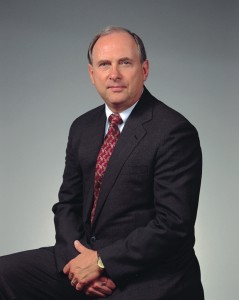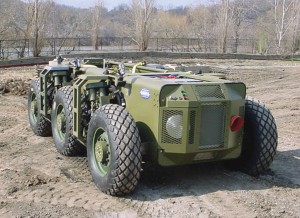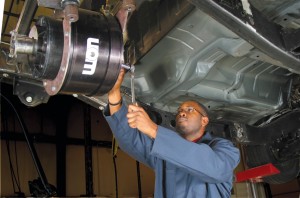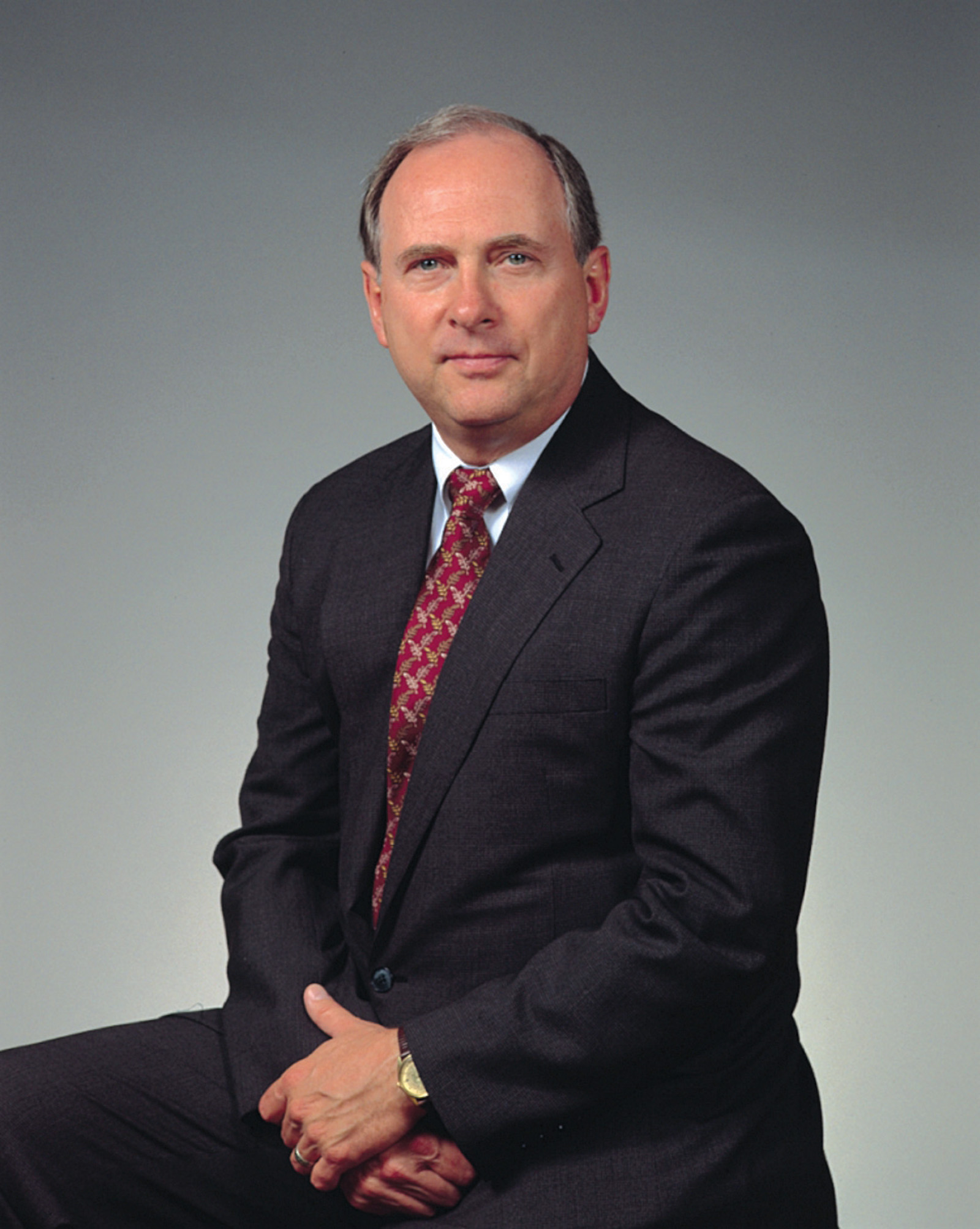By S. Clayton Moore

William G. Rankin, who developed John Deere’s manufacturing facilities, has led UQM for over a decade.
Like the powerhouse motors it produces, UQM Technologies is small but mighty. The company, based in Frederick, Colo., produces high efficiency electric motors, generators and power controllers that are used in a wide variety of industries. UQM motors are used in the automotive, aerospace, medical and military markets and can be found in vehicles ranging from wheelchairs to prototype aircraft to futuristic combat tanks.
UQM, which employs just 41 people, has been quietly setting the pace for the future of vehicle propulsion around the world for years. Now the company is ready to change gears, evolving from the cutting-edge development that has made its reputation into full-fledged mass production of its innovative devices.
The engineers and resident manufacturing experts at UQM are highly skilled in the motor business, having been involved in the production of battery-powered and hybrid vehicles for more than 30 years.
“We’ve been reborn a few times, but we’ve been at this game a long time,” said CEO William G. Rankin, who is leading the company through its fundamental shift in direction. “We’re not just a startup company that has suddenly discovered propulsion for hybrid vehicles. We have a long history on the subject.”
The company was founded in 1967 to produce dune buggies. Mounting fiberglass components loaded on top of Volkswagen frames, the company made over 10,000 dune buggies during its tenure. By the early 1970s, its leaders decided to take a run at electric cars, producing an all-electric vehicle dubbed “The Electrek.”
As California started legislating emissions requirements in the late 1970s and early 1980s, UQM was able to build upon its electric motor experience. In 1983, the company hired Gene Fisher, a former IBM scientist who was developing small, lightweight motors using permanent magnet materials, to scale that technology into vehicle-quality size.
Along the way, they created a mobile television platform used by ABC to provide live broadcast coverage of the 1984 Olympics and provided motors for 18 of the 32 participating cars in the first Sunrayce solar-powered car race in 1987. UQM also constructed a hybrid electric firefighting robot for use on U.S. Navy ships and completed the conversion of the first hybrid electric bus in North America for the State of New York.
By the early 1990s, they had gotten the attention of BMW, who contracted UQM to supply 21 propulsion systems for a series of 15 electric-powered concept cars designed to the California standards. In 1991, BMW showcased an all-electric vehicle at the Frankfort Auto Show with a UQM motor and controller.
“As a result of that early exposure, we’ve done business with nearly every auto company in the world that’s making prototypes,” Rankin said.
Despite the Zero Emission Vehicle mandate in California and the accompanying flurry of activity among the automakers, UQM wisely decided to diversify its interests, building not just motors for electric vehicles but also starters, alternators, air compressors and fuel pumps.
UQM hired Bill Rankin in February 1992 as executive vice president. He had served as a first lieutenant combat engineering officer with the 1st Cavalry Division in Vietnam, where he was awarded a Bronze Star (with Oak Leaf Cluster). He earned his BS in engineering mathematics from the Colorado School of Mines and later a master’s in systems management from the Florida Institute of Technology. He brought with him a wealth of operations experience gained from 16 years at John Deere & Company.
“I wasn’t an electric motor guy,” Rankin said. “My role was helping Deere change its factory from very large process-organized manufacturing into focused manufacturing cells.”
The first few years weren’t easy, as UQM struggled to develop its identity.
“It was a wild horse that was tough to ride,” Rankin admitted. “We were having a lot of technical problems early on but we finally got the technology under control. If a customer has a requirement today, we know how to design a motor to meet those requirements, and when we’re done, that motor will perform the way the customer wants.”

The “Spinner,” an unmanned ground combat vehicle, utilizes UQM motors in each of its six wheels and is virtually impossible to turn over.
Prior to the company’s change in direction over the last year, its efforts were largely funded by companies with very specific propulsion needs who turned to UQM for custom development.
“No one ever came here for low price, but they did come here for those applications that are demanding,” Rankin said. “We have a history of going out and getting paid by our customers. They decide we have the best technology and they fund our development of that technology.”
Those efforts have included motors and controllers for a number of diverse applications. UQM’s technology was incorporated in both hybrid electric and fuel cell vehicles for Ford, Nissan and Daimler Chrysler; several hybrid electric tractors for Rankin’s former employer John Deere; and into a heavy duty propulsion system in Eaton Corporation’s hybrid electric commercial truck. Other high-profile customers include Denver’s Regional Transportation District and the Department of Energy. Over 39,000 motors have been manufactured and fielded since the company began volume production operations in 1998.
While UQM’s motors and controllers are developed on a custom basis, the company maintains control over the technology behind the devices.
“We hang on to our intellectual property,” Rankin said. “We have sophisticated electronics and software that are becoming the real power behind our intellectual advantage. There’s been a lot invested over the years and we’re not prepared to let a newcomer come along and spend a little bit of money and get access to all our past invention.”
Most of its components are highly adaptable to a variety of vehicles. A single 120-kilowatt device, UQM’s SR286, has been used as a generator in a John Deere tractor, military Humvees and in city buses.
“We’re trying to go after markets where there is a value-add benefit from our technology,” Rankin said. “There’s such a broad field of applications for which we believe our technology has potential. We try to stretch ourselves as far as we possibly can to service the market and allow customers to access our technology.”
UQM’s motors, generators and other electric accessories have found their way into the aviation world, too. One UQM integrated motor recently passed rigorous DO-160D aircraft qualification testing and is being utilized by Keith Products of Texas as part of an air conditioning system for military and commercial aircraft.
UQM motors are also being used in two experiments in zero-emission flight. Boeing, in a partnership with five other companies, has contracted with UQM to flight test an aircraft powered by fuel cells using a UQM electric propulsion system. In another project funded partially by NASA, James Dunn is leading the Massachusetts-based Advanced Technology Products Corporation in developing the “E-Plane,” an aircraft that uses a 30-kilowatt UQM motor.
“The biggest benefit is the simplicity of the aircraft,” Dunn said. “We have one moving part, which is the armature of the motor. You can’t hear the motor at all. In terms of reliability and simplicity, but also in terms of the emissions, we have no pollution of any kind. We don’t have the kinds of issues you see with carburetor icing and all the other headaches associated with piston engines.”
To expand the market for its proprietary technology, UQM makes great efforts to pioneer new uses for its motors.
“We’ll design something for John Deere and then go use that application within a military vehicle,” Rankin explained. “John Deere doesn’t care because they’re not competing with the U.S. Government, so we’re able to leverage our machines into multiple markets.”
Although the bulk of UQM’s funding still comes from the private sector, its military market is expanding rapidly. The U.S. military has contracted with UQM for motors in a number of top-secret applications.
“The military wants to operate their vehicles in stealth mode, engine off, from batteries,” Rankin said. “They also want onboard electric power for other uses such as powering laser and microwave weapons that are electrically based.”

A technician integrates UQM’s 120-kilowatt motor into a Chevy Silverado to meet the needs of a U.S. Air Force contract.
One military vehicle where UQM technology is being used is in the “Spinner,” being built by a team led by the National Robotics Engineering Consortium, a unit of Carnegie Mellon University’s Robotics Institute. Dubbed a hybrid electric unmanned ground combat vehicle, the Spinner utilizes UQM high-torque propulsion motors in each of its six wheels.
“Its performance is absolutely incredible,” Rankin said of the vehicle. “It can climb walls and span ditches. UQM is credited with allowing that vehicle to achieve those capabilities.”
The most significant development in the hybrid electric industry has been the success of the Toyota Prius, which has prompted a high demand for hybrid vehicles both in the U.S. and overseas. The repercussion from Toyota’s success is having a significant impact on UQM’s strategy, leading the company to transition from being a high-end boutique shop focused on research and development into a new charge towards production.
“Toyota’s success was really the driver for our current shift,” Rankin said. “With this new level of interest in hybrid electric motors from both longstanding and current customers, we realized that this isn’t the flash in the pan that we saw in California. We decided that we have to change our approach to the business.”
Simultaneously, UQM also made several technological leaps that make going to market with a standard product more practical. First, UQM managed to develop a 10-to-1 constant power speed ratio in its high-end motors.
“That means we’re able to take the motor up to ten times its base speed as well as to perform all the low-end torque,” Rankin explained. “That eliminates the need for a transmission. We’re able to achieve the low-end lugging of a tractor pulling a plow through a wet field as well as being able to take that vehicle up to road speed to get between fields.”
UQM also figured out a way to pulse energy to a motor without heating it up significantly and increased the peak power of the motor by up to 33 percent through improvements to its software.
“These were significant developments that really gave us some very high-performing machines,” Rankin said.
One problem UQM intends to tackle with this technology is pollution. New limits on particulates expelled by diesel engines were part of a package passed recently by Congress that will take effect in 2007 and 2010. By powering “parasite” components such as fuel, water and oil pumps, as well as fan drives through electrification, UQM’s engineers believe that diesel emissions can be reduced below the legislated levels.
“Once they are electrified, you can move those components away from the engine and modulate their performance, variable speed and power,” Rankin said. “A lot of people think our work here is fuel-consumption dependent, but a lot of the work is being driven by the need to reduce the emission particulates in the air.”
To accomplish a shift to production, UQM has made major changes to their internal infrastructure. The company raised $7.74 million last December by selling 3.6 million shares of common stock, raising UQM’s cash balance to $10.6 million, the largest amount in the history of the company. Those funds are intended to cover the costs of moving resources from customer-funded work to UQM-funded work.
Rankin also brought on a new team with significant experience in developing low-cost designs including a new vice president of operations, Ron Burton, as well as a new director of manufacturing, quality assurance engineer and a motor designer.
“Now that we’ve proven that these motors work and the customers are convinced that they work, it becomes a question of producing them in volume, to the quality standards of the customer, at prices to make them viable,” Rankin said. “That’s where we’re focusing the majority of our efforts.”
To effect this change, UQM has also reconfigured the floor space of its 31,000-square-foot factory facility in Frederick to allow for automated assembly cells to be constructed. It has an additional 2.5 acres to expand into and may set up further operations in China and Mexico. Rankin doesn’t expect UQM to grow significantly in terms of labor due to the use of automation to build motors and other devices.
“We expect to assemble our products here in the United States but we also expect to get the benefits of low-cost production by getting the components overseas,” Rankin said. “We have the ability to go to the best suppliers anywhere on the planet that can provide the most quality at the least cost to meet our needs.”

This 120-kilowatt motor developed by UQM has made its way into Humvees, buses and John Deere tractors.This 120-kilowatt motor developed by UQM has made its way into Humvees, buses and John Deere tractors.
Rankin’s experience in building automated manufacturing for John Deere should come in handy in UQM’s efforts, which he hopes will be a showcase for potential customers.
“The fact that we don’t yet have that manufacturing credibility is probably our biggest challenge right now,” Rankin said. “I believe that getting some initial customers to commit to some serious production will let us build up our manufacturing operation and help significantly.”
It’s a serious change in direction for UQM.
“We’re almost consciously not chasing the future as we have in the past,” Rankin said. “We’re trying to get our technology integrated into what we see as a significant shift in power systems and in vehicles at large.”
Traded publicly (AMEX:UQM), the company has lost money for the past five years but its losses have been slowly decreasing. This year alone, UQM carried a loss of $1.9 million on revenue of $4.7 million. To combat those losses, UQM is also pursuing a secondary strategy to gain customers in less technologically-driven areas.
“To jumpstart the revenue side, we’re going after markets that aren’t hybrid,” Rankin said. “With our strategy of sourcing internationally and doing highly automated assembly, we’re going after some companies that we’re not serving today that are buying lots of motors from someone else. We’re pursuing those companies with the expectation that we’re going to displace their current supplier. It’s not a technology-driven opportunity but a cost-driven opportunity.”
The company’s years of experience have given its leadership tremendous faith in the potential of electric engines.
“Most people think electric devices are weak, like a golf cart, and they’re not,” Rankin said. “Electric motors and electric machines will outperform conventional motors hands-down with better torque, instant torque, and better efficiency. The biggest challenge is coming up with a source of energy.”
Once a customer such as John Deere goes to market using UQM’s technology, Rankin hopes those ideas about electric motors will change.
“Things are still moving a little slower than we would expect,” Rankin said. “We’re all a bit frustrated at the pace that this technology is being fielded by our customer, but we feel we’re in an excellent position.”
In short, he feels the time is right for UQM to stake its place in the manufacturing world.
“We’ve been on the exotic, bleeding-edge end of things for the life of the company and we’ve built up an impressive technology portfolio and a strong list of blue-chip customers who have come here to access our technology,” Rankin said. “It’s time now that we move to production and get a payback on these investments.”
For more information on UQM Technologies, Inc., visit [http://www.uqm.com].











